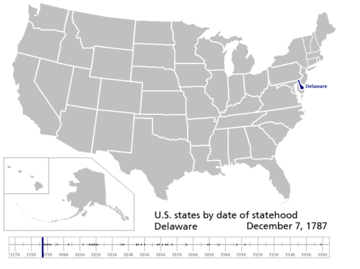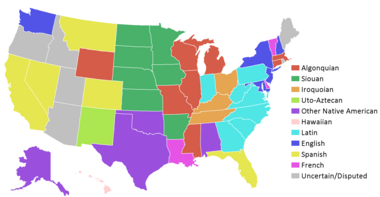U.S. state facts for kids
Quick facts for kids State |
|
|---|---|
| Also known as: Commonwealth (the self-designation of four states) |
|
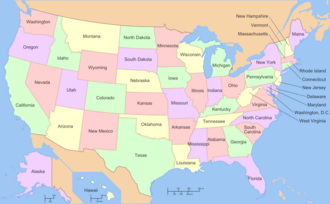 |
|
| Category | Federated state |
| Location | United States |
| Number | 50 |
| Populations |
|
| Areas |
|
| Government | State government |
| Subdivisions | County (or equivalent) |
In the United States, a state is like a large, important part of the country. There are 50 states that are all connected in a group. Each state has its own government and controls its own area. They share power with the main U.S. government.
Because of this shared power, people in the U.S. are citizens of both the whole country and the state where they live. You can usually move between states without needing special permission, unless a court order limits you.
State governments get their power from the people in each state through their own state constitutions. All state governments are based on republican ideas, which means the people have the power. Each state government has three main parts, or branches, that work separately: the executive (like the leader), the legislative (who make laws), and the judicial (who interpret laws).
States are divided into smaller areas called counties. Counties can have some local government power, but they are not independent like states. States also create other local governments for cities and towns.
States have many important powers and rights under the United States Constitution. States and their citizens have representatives in the United States Congress, which is made of two parts: the Senate and the House of Representatives. Each state also helps choose the president of the United States through a group called the Electoral College. States can also approve changes to the Constitution.
Historically, states were mainly in charge of things like local police, schools, public health, and local transportation. They also handle elections for local, state, and national leaders. Over time, the main U.S. government has become more involved in these areas, often providing funding and rules. There's an ongoing discussion about states' rights, which is about how much power states should have compared to the federal government.
The Constitution allows Congress to add new states to the country. When the U.S. started in 1776, there were 13 states. Now there are 50! Each new state joins with the same rights as the older ones. After the American Civil War (1861–1865), the U.S. Supreme Court decided that a state cannot leave the country on its own.
Contents
All the U.S. States
Here are the 50 U.S. states in alphabetical order, along with their flags:
 Alabama
Alabama Alaska
Alaska Arizona
Arizona Arkansas
Arkansas California
California Colorado
Colorado Connecticut
Connecticut Delaware
Delaware Florida
Florida Georgia
Georgia Hawaii
Hawaii Idaho
Idaho Illinois
Illinois Indiana
Indiana Iowa
Iowa Kansas
Kansas Kentucky
Kentucky Louisiana
Louisiana Maine
Maine Maryland
Maryland Massachusetts
Massachusetts Michigan
Michigan Minnesota
Minnesota Mississippi
Mississippi Missouri
Missouri Montana
Montana Nebraska
Nebraska Nevada
Nevada New Hampshire
New Hampshire New Jersey
New Jersey New Mexico
New Mexico New York
New York North Carolina
North Carolina North Dakota
North Dakota Ohio
Ohio Oklahoma
Oklahoma Oregon
Oregon Pennsylvania
Pennsylvania Rhode Island
Rhode Island South Carolina
South Carolina South Dakota
South Dakota Tennessee
Tennessee Texas
Texas Utah
Utah Vermont
Vermont Virginia
Virginia Washington
Washington West Virginia
West Virginia Wisconsin
Wisconsin Wyoming
Wyoming
How States Started
The first 13 states began in July 1776 during the American Revolutionary War. They were originally British colonies. After deciding to become independent, they joined together under the first U.S. constitution, called the Articles of Confederation. During this time, these new states also wrote their own state constitutions, which were some of the first written constitutions in the world.
These early state constitutions were all about giving power to the people and dividing government into three branches. Later, from 1787 to 1790, each state also approved the new Constitution of the United States. This new Constitution explained how the states and the federal government would share power, a system called federalism.
How State Governments Work
In the U.S., each of the 50 states and the country as a whole are considered independent in their own ways. States are not just smaller parts controlled by the main government. The Tenth Amendment to the United States Constitution says that any power not given to the federal government belongs to the states or to the people.
This means each state can set up its own government in a way that its people choose, as long as it follows the U.S. Constitution. States can make laws for the well-being of their people. So, while state governments have many similar features, they are not exactly alike. No two state governments are identical!
State Constitutions
Each state's government follows its own constitution. Many of these state constitutions are much longer and more detailed than the U.S. Constitution. For example, the Constitution of Alabama used to have over 310,000 words! Even though it's not required, every state has chosen to have a government with three branches: executive, legislative, and judicial.
Some states, like Virginia, Pennsylvania, Massachusetts, and Kentucky, call themselves "Commonwealths" instead of "states" in their constitutions. This word means "a state where the people hold the highest power." It's just a different name, but they are still states like all the others.
State Leaders: Governors
The main leader in each state is called the governor. The governor is like the head of the state and the head of the state's government. People in the state vote directly to choose their governor. The governor can approve or reject (veto) laws passed by the state legislature. They can also suggest new laws.
In most states, the governor is not the only elected leader in the executive branch. Other officials, like the lieutenant governor or attorney general, are also chosen by the people.
In some states, citizens can vote to remove an elected official, including the governor, before their term ends. This is called a recall election. Also, state lawmakers can remove state officials who have seriously misused their power through a process called impeachment and a trial.
State Lawmakers: Legislatures
The main job of state legislatures is to make state laws and decide how to spend money for public services. If a governor rejects a bill, the legislature can still make it a law if enough lawmakers vote for it again (usually a two-thirds vote).
In 49 out of 50 states, the legislature has two parts: a lower house (often called the House of Representatives or General Assembly) and a smaller upper house, which is always called the Senate. The only state with just one legislative house is Nebraska.
Most states have "part-time" legislatures, meaning lawmakers don't work on laws all year long. Ten states have "full-time" legislatures, which work more like the U.S. Congress.
People in each state vote directly to choose their state lawmakers. The U.S. Supreme Court has ruled that all states must make sure that each citizen has the same amount of representation. This means that areas with more people should have more representatives.
State Courts: Judicial System
States can set up their court systems differently from the federal courts, as long as they protect people's basic rights. Most states have a trial court (where cases start), an appeals court (where decisions can be reviewed), and a supreme court (the highest court in the state).
Most criminal and civil cases in the U.S. are handled in state courts. About 30 million new cases are filed in state courts each year, compared to about 1 million in federal courts.
Most states follow a legal system based on English common law. However, Louisiana, which was once a French colony, uses parts of French civil law in its legal system.
In most states, judges are either elected or appointed for a certain number of years. They can usually be re-elected or reappointed. Only a few states have judges who serve for life.
Local Governments
All states are "unitary states," meaning that local governments (like cities and counties) are created by state law and are under the state's authority. State governments often give some power to local areas and tell them how to carry out state decisions. In some states, local governments have a bit more freedom to make their own rules.
States decide what powers their local governments will have. Generally, local governments can be given power over:
- Structure: How their government is set up.
- Functions: What local services they provide.
- Money: How they get money (like taxes) and spend it.
- People: Rules for their employees.
How States Work Together
Between States
When a new state joins the U.S., it has the same rights and powers as the original states. States can make agreements with each other, called "interstate compacts," with Congress's approval. These agreements are often used to manage shared resources, like rivers or transportation.
Under the U.S. Constitution, states must respect the laws and court decisions of other states. For example, most contracts and criminal judgments from one state are recognized in another. If someone accused of a crime flees to another state, that state must usually return them.
States cannot treat citizens from other states unfairly when it comes to their basic rights.
With the U.S. Federal Government
The Constitution promises each state a government based on republican ideas, where the people have a say. States are also promised protection from invasion and from serious violence within their borders if their leaders ask for help.
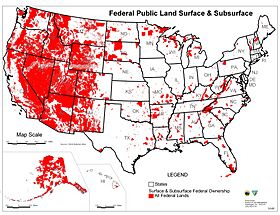
The Constitution also says that the U.S. Constitution, federal laws, and treaties are the highest laws in the land. State courts must follow these federal laws. Even state constitutions are less powerful than federal law.
The idea of States' rights is mainly linked to the Tenth Amendment. This amendment says that any powers not given to the national government, and not forbidden to the states, belong to the states or to the people. For example, Congress has the power to declare war, but states cannot.
Congress also has the power to regulate business between states. Over time, the Supreme Court has interpreted this "Commerce Clause" to give the federal government much more power than it used to have, even over things that seem local. For example, Congress can regulate train traffic within a state if it affects business across state lines. This power has been used for things like civil rights laws.
Another power of Congress is to collect taxes and spend money. For example, the federal government provides a lot of money for highways. By offering or holding back highway funds, Congress has encouraged states to pass certain laws, like the national legal drinking age of 21.
Each state has two senators in the Senate, no matter how many people live there. In the House of Representatives, the number of representatives each state has depends on its population, which is counted every ten years. Both senators and representatives are chosen by direct vote in their states.
When people vote for president and vice president, they are actually voting for "electors" from their state. These electors then officially choose the president and vice president. Each state gets a number of electors equal to its total number of senators and representatives.
State laws, not federal laws, control most parts of elections in the U.S., including how people vote and how the electoral college works in each state.
States also play a key role in changing the U.S. Constitution. Changes can be suggested by Congress or by a special meeting called by two-thirds of the state legislatures. To become part of the Constitution, a change must be approved by three-quarters of the states.
With Other Countries
U.S. states are not considered independent countries in international law. The federal government is in charge of international relations (dealing with other countries). However, state and local leaders sometimes travel to other countries to build economic and cultural connections.
How New States Join the U.S.
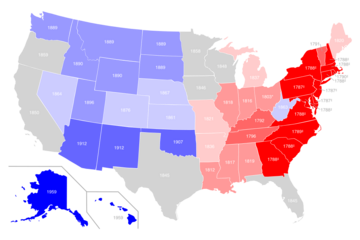
1776–1790 1791–1796
1803–1819 1820–1837
1845–1859 1861–1876
1889–1896 1907–1912
1959
The Constitution gives Congress the power to add new states. Since the U.S. started in 1776, the number of states has grown from 13 to 50. Each new state has joined with the same rights as the older ones. The Constitution also says that new states cannot be created from parts of existing states without the permission of both the affected states and Congress.
Most states that joined after the original 13 were formed from areas called "territories" that were managed by Congress. The process for this was set up by the Northwest Ordinance in 1787.
When people in a territory want to become a state, Congress might pass a law allowing them to write a state constitution. After they write their constitution and elect state leaders, Congress can then officially admit them as a state.
Six states, besides the original 13, were not organized territories before joining the U.S.:
- California (1850) came from land given to the U.S. by Mexico.
- Kentucky (1792) was part of Virginia.
- Maine (1820) was part of Massachusetts.
- Texas (1845) was its own country before joining.
- Vermont (1791) was also its own republic.
- West Virginia (1863) separated from Virginia during the Civil War.
Congress doesn't have to admit a territory as a state, even if the people there want it. This has happened many times. For example, the "State of Deseret" (in what is now Utah) and the "State of Sequoyah" (in what is now Oklahoma) were proposed but never approved by Congress.
Sometimes, a state's entry was delayed because of problems. For example, Michigan Territory's statehood was delayed due to a border dispute. Kansas Territory's statehood was held up by violent conflicts over slavery.
Future State Possibilities
Puerto Rico
Puerto Rico is a U.S. territory. It calls itself a "Commonwealth." People living in Puerto Rico do not have full representation in the U.S. Congress. They have a representative who can speak but has limited voting rights.
People in Puerto Rico have voted several times on whether to become a state, become independent, or have a different relationship with the U.S. In recent votes, more people have chosen statehood. In 2020, they voted for statehood and elected a pro-statehood governor.
Washington, D.C.
The U.S. capital, Washington, D.C., was created to be a neutral place, not part of any state. Because it's not a state, people in D.C. don't have senators and only have a non-voting representative in the House. Before 1961, they couldn't even vote for president.
Most people in Washington, D.C., want it to become a state. In 2016, 86% of voters supported statehood. For D.C. to become a state, Congress must approve it.
Can States Leave the U.S.?
The Constitution talks about a "union" but doesn't clearly say if a state can leave. The first U.S. constitution, the Articles of Confederation, said the union would be "perpetual" (forever). The question of whether states could leave was a big debate in U.S. history, especially leading up to the American Civil War.
In 1860 and 1861, 11 southern states declared they were leaving the U.S. and formed the Confederate States of America. After the Civil War ended in 1865, these states rejoined the U.S. The federal government never agreed that they had legally left.
After the war, the U.S. Supreme Court ruled in 1869 that states do not have the right to leave the country on their own. The Court said that the U.S. was meant to be a "more perfect union" and that states could not just decide to leave. This means a state can't unilaterally leave the Union.
Where State Names Come From
The names of the 50 states come from many different languages.
- Twenty-four state names come from Native American languages.
- Hawaii's name comes from the Polynesian Hawaiian language.
- Twenty-two names come from European languages, mostly Latin, English, Spanish, and French.
- Eleven states are named after people, including seven named for kings or queens, and one after a U.S. President.
- The origins of six state names are unknown or debated.
State Geography
State Borders
The borders of the first 13 states were mostly set by their original colonial rules. Their western borders changed as states gave up land to the federal government. Many other state borders were set by Congress when it created and divided territories. These borders often followed natural features like rivers or mountains. In the western U.S., many borders are straight lines following latitude and longitude.
Once set, most state borders have stayed the same. Only Missouri and Nevada grew noticeably after becoming states. Some original states gave land to the federal government, which later became new territories or states. For example, Maryland and Virginia gave land to create Washington, D.C..
There have been small changes to borders over the years due to better maps or agreements between states. Sometimes, Congress or the Supreme Court has to settle border disputes. For example, New Jersey won most of Ellis Island from New York in 1998.
Once a territory becomes a state, the state must agree to any changes to its borders or powers.
State Groupings
States can be grouped into regions in many ways. The U.S. Census Bureau divides the country into four main regions: Northeast, Midwest, South, and West. This grouping is often used for collecting and analyzing information. Other regions are unofficial and are based on geography or shared culture.
See also
 In Spanish: Estado de los Estados Unidos para niños
In Spanish: Estado de los Estados Unidos para niños
- Insular area
- ISO 3166-2:US
- Lists of U.S. state topics
- Local government in the United States


